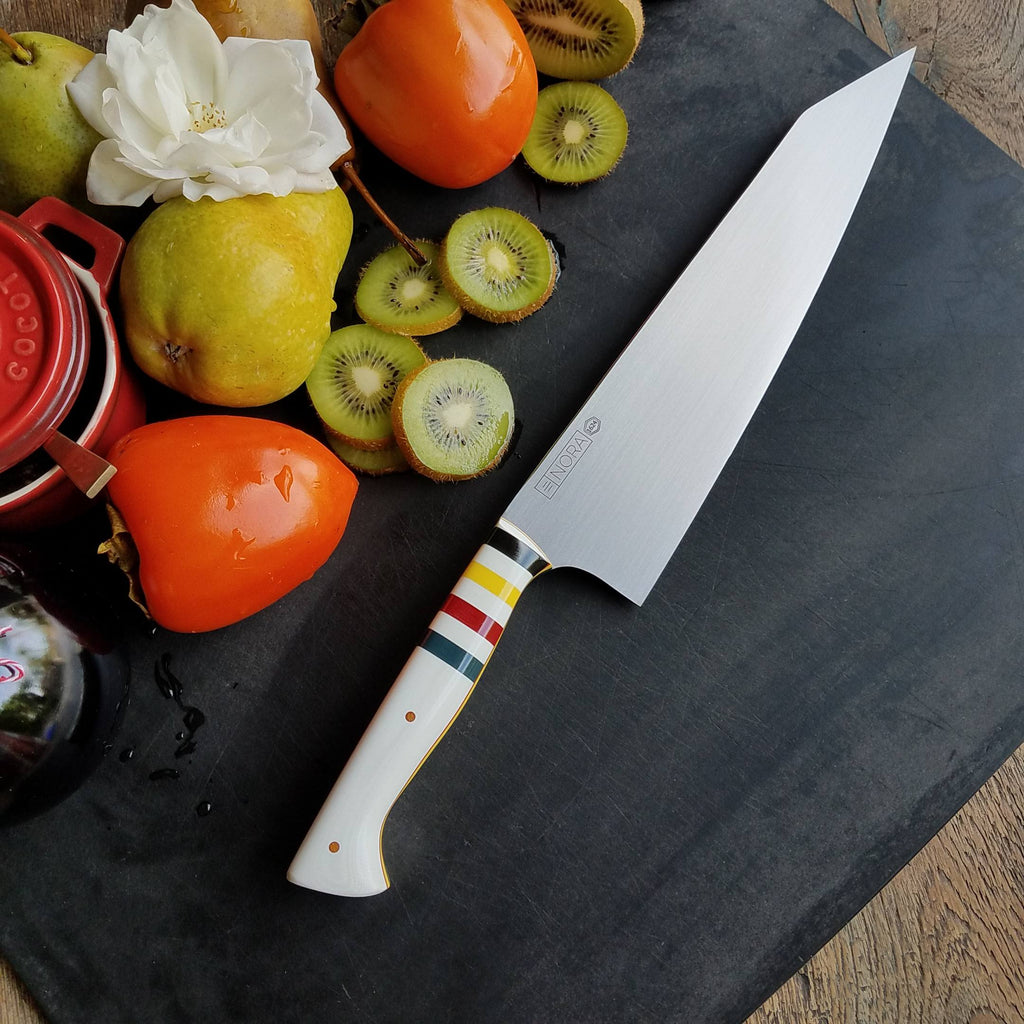
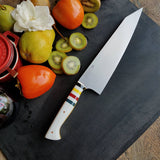

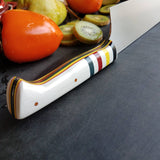

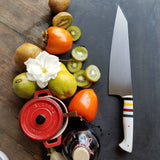

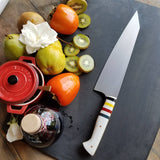
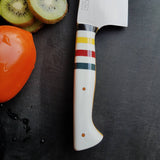
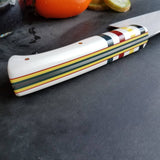
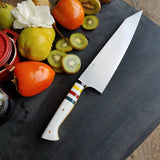
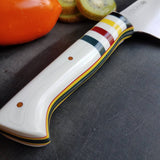
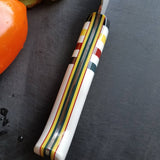
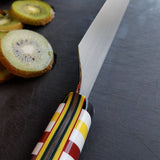
NORA #1624 - 10 Inch Kiritsuke - Hudson Bay Blanket
$ 448.00
KNIFE HIGHLIGHTS
- Blade Type: Kiritsuke
- Blade Length: 10 Inches
- Total Length: 15 Inches
- Handle Style: Western | Right or Left Hand Use
- Steel: AEB-L Stainless Steel
- Handle Materials: White | Red | Yellow | TForest Green G10, Natural Micarta Pins
- Rockwell Hardness: 62 HRC
- Grind Type: Full Flat Hybrid - Performance Grind (3 different bevels blended)
- This Blade is Ground...
- Thin for Performance (best performance but delicate)
- Thick for Durability (tough, built to last for heavy wear-n-tear)
- >>> Mid-Range with Special Geometry (specially ground for food release and glide but blade is kept slightly thicker for durability)
- This Knife Feels...
- Heavy in Hand (Hefty. Durable.)
- Light (nimble, maneuverable)
- >>> Not too heavy, not too light (Switzerland. Fitting weight for the size of the knife.)
GENERAL USES OF THIS KNIFE:
KIRITSUKE KNIFE
This blade shape is our take on the traditional Japanese Kiritsuke knife.
A Kiritsuke knife is one of the very few Japanese knives that is considered multi-purpose. It is a hybrid between a Yanagi (fish slicer) and a Usuba (vegetable knife.). A Kiritsuke knife works well for slicing and breaking down protein but it also excels at vegetable prep. and general purpose tasks. In Japanese kitchens, the Kiritsuke knife is reserved only for the executive Chef as a sign of respect and also due to the skill needed to efficiently use these knives.
Our Kiritsuke design does not have as flat of a belly as the more traditional Japanese style knives. We have done this to allow just the slightest amount of rock in the cut. We feel it adds a bit more versatility to the knife.
HANDLE DESIGN & MATERIALS:
Every one of our knives is handmade, unique and numbered. This NORA knife has been handled with a mix of uber-durable G10 in a handful of colors. We patterned the handle after the familiar Hudson Bay Striped Blanket. Pendelton also makes a version. Who came first...we know not. We just know that the pattern makes us feel like cooking hot chocolate and wearing immense amounts of flannel. We varied the design a little as the white is a bright white and not ivory but it has that same cozy, campy vibe that we love.
So what is G10? G10 is an incredibly strong & durable fiberglass laminate that was originally used in the electronics industry. It has been adapted in the knife making world and has proven to be an excellent material for handles as it has high strength, low moisture absorption and can be found in a variety of colors. It’s one of our favorite materials to work with outside of wood.
STEEL INFORMATION:
AEB-L STAINLESS STEEL
This knife blade is composed of AEB-L stainless steel which is a high-quality Swedish metal, originally developed for razor blades. Recently, steel suppliers have made this steel available in thicker sheets and it has proven to be an excellent adaptation for the cutlery industry.
AEB-L has a beautiful balance of carbon and chromium and, with proper heat treatment, this steel produces both a very fine edge as well as excellent toughness and edge stability. The fine grain structure also makes this steel very easy to sharpen. We believe it is one of the finest stainless steels available on the market today for use with kitchen knives.
As a side note, there are two things we like to mention about this steel:
1.) This steel responds beautifully to honing and if the knife is honed regularly it should need infrequent sharpening.
2.) AEB-L is a stainless steel but just barely. The higher carbon content in this stainless is what allows it to get a fine edge and higher hardness than other stainless steels but it also has a tendency to sometimes form very fine rust spots on the blade. If this happens, these are easily removed with a green scotch brite pad and usually the rough end of a kitchen sponge will also do the trick.
